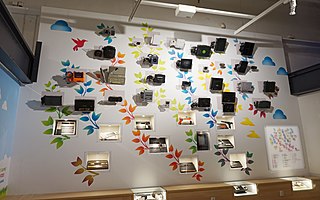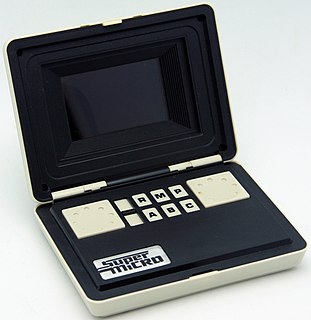This is an (incomplete) list of electronic games released by VTech, along with their format and date of release, if known. See lists of video games for related lists. Starting in the early 1980s, VTech launched a series of portable and table top games that made use of LCD, VFD and LED displays. [1] [2] [3] One brand used by VTech, the Time & Fun series, seems to be an attempt to cash on the electronic handheld craze started by the Game & Watch series.
Some of VTech's games were distributed in the US by Palmtex under their name, like the Tri-Screen Time & Fun series.
Coleco Industries, Inc. was an American company founded in 1932 by Maurice Greenberg as The Connecticut Leather Company. It was a successful toy company in the 1980s, mass-producing versions of Cabbage Patch Kids dolls and its video game consoles, the Coleco Telstar dedicated consoles and ColecoVision. While the company ceased operations in 1988 as a result of bankruptcy, the Coleco brand was revived in 2005, and remains active to this day.

A handheld game console, or simply handheld console, is a small, portable self-contained video game console with a built-in screen, game controls and speakers. Handheld game consoles are smaller than home video game consoles and contain the console, screen, speakers, and controls in one unit, allowing people to carry them and play them at any time or place.

Super Mario Land is a 1989 side-scrolling platform video game developed and published by Nintendo as a launch game for its Game Boy handheld game console. It is the first Mario platform game to have been released for a handheld console. In gameplay similar to that of the 1985 Super Mario Bros., but resized for the smaller device's screen, the player advances Mario to the end of 12 levels by moving to the right and jumping across platforms to avoid enemies and pitfalls. Unlike the other Mario games, Super Mario Land is set in Sarasaland, a new environment depicted in line art, and Mario pursues the debuting Princess Daisy. The game has two Gradius-style shooter levels.

Gunpei Yokoi, sometimes transliterated Gumpei Yokoi, was a Japanese video game designer. He was a long-time Nintendo employee, best known as creator of the Game & Watch handheld system, inventor of the cross-shaped Control Pad, the original designer of the Game Boy, and producer of a few long-running and critically acclaimed video game franchises such as Metroid and Kid Icarus.
Tiger Electronics Ltd. was an independent American toy manufacturer best known for its handheld LCD games, the Furby, the Talkboy, Giga Pets, the 2-XL robot, and audio games such as Brain Warp and the Brain Shift. When it was an independent company, Tiger Electronics Inc., its headquarters were in Vernon Hills, Illinois. It has been a subsidiary of Hasbro since 1998.
In the history of video games, the sixth-generation era is the era of computer and video games, video game consoles, and handheld gaming devices available at the turn of the 21st century, starting on November 27, 1998. Platforms in the sixth generation include consoles from four companies: the Sega Dreamcast (DC), Sony PlayStation 2 (PS2), Nintendo GameCube (GC), and Microsoft Xbox. This era began on November 27, 1998, with the Japanese release of the Dreamcast, which was joined by the PlayStation 2 on March 4, 2000, and the Xbox and Gamecube on November 15 and 18, 2001, respectively. In April 2001, the Dreamcast was among the first to be discontinued. Xbox in 2006, GameCube in 2007 and PlayStation 2 was the last, in January 2013. Meanwhile, the seventh generation of consoles started on November 22, 2005, with the launch of the Xbox 360.

A home video game console is a video game console that is designed to be connected to a display device, such as a television, and an external power source as to play video games. Home consoles are generally less powerful and customizable than personal computers, designed to have advanced graphics abilities but limited memory and storage space to keep the units affordable. While initial consoles were dedicated units with only a few games fixed into the electronic circuits of the system, most consoles since support the use of swappable game media, either through game cartridges, optical discs, or through digital distribution to internal storage.

Simon is an electronic game of short-term memory skill invented by Ralph H. Baer and Howard J. Morrison, working for toy design firm Marvin Glass and Associates, with software programming by Lenny Cope. The device creates a series of tones and lights and requires a user to repeat the sequence. If the user succeeds, the series becomes progressively longer and more complex. Once the user fails or the time limit runs out, the game is over. The original version was manufactured and distributed by Milton Bradley and later by Hasbro after it took over Milton Bradley. Much of the assembly language code was written by Charles Kapps, who taught computer science at Temple University and also wrote one of the first books on the theory of computer programming. Simon was launched in 1978 at Studio 54 in New York City and was an immediate success, becoming a pop culture symbol of the 1970s and 1980s.

Radica Games Limited was an American company that produces electronic games, founded in 1983. It began by producing electronic souvenir games for casinos. In the late 1990s, it became known for its Bass Fishin line of games. On October 3, 2006, Mattel, Inc. announced the completion of their acquisition of Radica. While Radica produced electronic handheld games based on casino or card games, it has branched out into toys, board games, and video game accessories.
VTech is a Hong Kong-based global supplier of electronic learning products from infancy to preschool and the world's largest manufacturer of cordless phones.

Handheld electronic games are very small, portable devices for playing interactive electronic games, often miniaturized versions of video games. The controls, display and speakers are all part of a single unit. Rather than a general-purpose screen made up of a grid of small pixels, they usually have custom displays designed to play one game. This simplicity means they can be made as small as a smartwatch, and sometimes are. The visual output of these games can range from a few small light bulbs or LED lights to calculator-like alphanumerical screens; later these were mostly displaced by liquid crystal and vacuum fluorescent display screens with detailed images and in the case of VFD games, color. Handhelds' popularity was at its peak from the late 1970s into the early 1990s before declining. They are the precursors to the handheld game console.
An electronic game is a game that uses electronics to create an interactive system with which a player can play. Video games are the most common form today, and for this reason the two terms are often used interchangeably. There are other common forms of electronic game including handheld electronic games, standalone systems, and exclusively non-visual products.

The Video Technology CreatiVision is a hybrid computer and home video game console introduced by VTech in 1981 and released in 1982. The hybrid unit was similar in concept to computers such as the APF Imagination Machine, the older VideoBrain Family Computer, and to a lesser extent the Intellivision game console and Coleco Adam computer, all of which anticipated the trend of video game consoles becoming more like low-end computers.

The V.Smile is a sixth-generation educational home video game console manufactured and released by VTech. Titles are available on ROM cartridges called "Smartridges", to play off the system's educational nature. The graphics are primarily sprite-based. The console is often sold bundled with a particular game, with most of them having a game called Alphabet Park Adventure. Several variants of the V.Smile console are sold including handheld versions, or models with added functionality such as touch tablet integrated controllers or microphones. The V-Motion is a major variant with its own software lineup that includes motion sensitive controllers, and has Smartridges designed to take advantage of motion-related "active learning". The V-Motion and Smartridges however, are fully backwards compatible with other V.Smile variants and V.Smile Smartridges, and a V-Motion Smartridge can also be played on V.Smile console or handheld, albeit with limited functionality. However, in 2010, the new and old models of the V.Smile were discontinued. VTech still made games for the V.Smile until 2012.

The Game Boy is an 8-bit fourth generation handheld game console developed and manufactured by Nintendo. It was first released in Japan on April 21, 1989, in North America later the same year, and in Europe in late 1990. It was designed by the same team that developed the Game & Watch series of handheld electronic games and several Nintendo Entertainment System (NES) games: Satoru Okada, Gunpei Yokoi, and Nintendo Research & Development 1.
Grandstand is a video game console and electronic game manufacturer and distributor. It was based in the United Kingdom and New Zealand and was active in the 1970s and 1980s.
Nelsonic Industries was an American electronics manufacturing and development company that operated from Long Island City, Queens, New York City in the early 1980s and throughout the 1990s when it was acquired by the watch-manufacturer, M.Z. Berger. Nelsonic produced numerous toy-themed wristwatches, often targeting younger audiences with likenesses of characters from popular franchises such as Barbie, the Ghostbusters, and Mario. Nelsonic became notable during the early mid-1980s for being the first electronics company in the United States to produce game-watches. For a period subsequent to its purchase by M.Z. Berger, Nelsonic operated as a subsidiary division of its parent company and game-watches were produced that bore the Nelsonic mark. This practice ended as M.Z. Berger shifted focus to more traditional and higher-end timepieces. Today the original Nelsonic Game Watch line has entered the secondary market and individual Game Watches have become highly sought-after collectibles that often fetch high prices on eBay and other online auction websites.
APF Electronics, Inc. was a publicly traded company in the United States dedicated to consumer electronics. The company's name comes from the initials of the two brothers who founded the company, Al & Phil Friedman.

The Palmtex Portable Videogame System (PVS), later renamed and released as the Super Micro and distributed under the Home Computer Software name, is a handheld game console developed and manufactured by Palmtex, released in 1984.